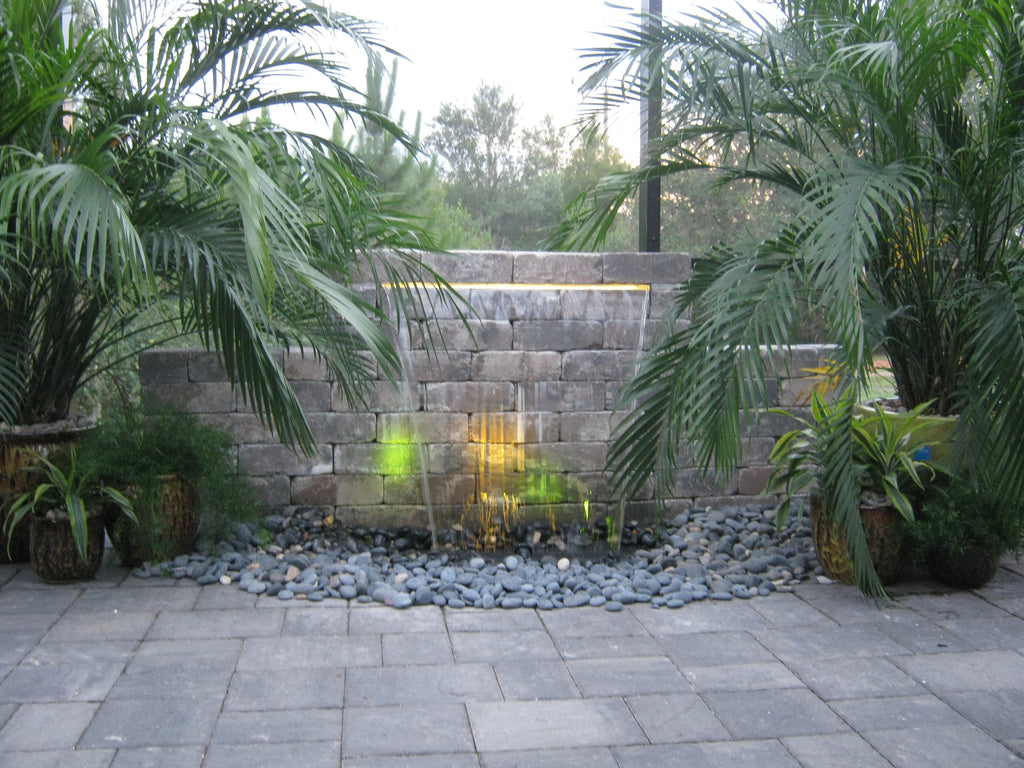I'm sure you've seen a disappearing water feature at a friend's home or perhaps the in the garden patio of a favorite restaurant. We’ve all seen them, and they continue to grow in popularity in large part because they are easy to install and operate.
The waterfall that disappears into a bed of river rock; the bubbling urn that entertains with a mix of brightly glazed color and dancing, living water; the soothing stream that flows along a pathway and out of sight below a bridge.

Disappearing water features have a wow factor and intrigue about it that is hard to replicate with other water design elements. And of course, the first question we hear from many of our customers is “Where does the water go?”
Should You Build One?
Disappearing water features are common in public and commercial settings, and they are gaining in popularity with homeowners as well. Some of the reasons people find them attractive is because of their easy of installation, relatively low cost, low maintenance requirements, small footprint, and their versatility and ability to integrate a variety of materials.
For professionals, they can be the excellent solution, a great landscaping add-on for existing clients or a simple way to create a wow factor in a very short amount of time. But to make a disappearing water feature work effectively, you must know all your options and when to use what equipment, from what the customer sees on the surface to the subsurface equipment that makes the feature truly unique.

The Challenge
One of the first challenges you face with disappearing water features is really no different from that of installing any other water feature — identifying the weakness is a landscape design and offering a perfect visual solution that matches the purpose, backdrop and feel of the area.
We know that bubbling urns are ideal if you are looking for a quiet visual effect and a little splash of color. These fit nicely in small gardens, commercial settings, contemporary buildings and where sight is more important than sound.
However, if you are working in a turf yard or a grove of trees, a waterfall or meandering stream that drops the water into a bed of gravel and disappears right in front of your eyes is more appropriate to the natural settings. Once you have visualized the proper feature, you must equip it correctly.
There are endless options on the market for disappearing feature basins that come in a variety of shapes, sizes and weight limits.
Small features can use magnetic drive pumps, but make sure you choose a brand that can pass particles and has a strong impeller. In my experience, Laguna MaxFlow pumps are great for these features, as they not only have nearly indestructible impellers, but they are housed in a large filtering basket to keep particles from getting to the pump, increasing the surface area of suction. In larger and natural features where some sand and larger particles could get into the basin, I prefer horsepower pumps made by Matala and Performance Pro, which have a strong record of performance and can pass the particles without causing damage to the impeller.
With disappearing water features, we are not interested in biofiltering the water to keep it healthy. Instead, we are interested in water clarity and algae control. How we accomplish this is again determined by the feature design and the client’s desires. Do we need equipment or additives? With some features, accepting the added cost of equipment to control algae up-front is the right thing to do. Ionizers help control algae growth on rock surfaces and can be very helpful when installed inline to keep your feature looking fresher and decrease the wet-rock algae visual. A UV clarifier can be a nice addition if there is pooling water, where the suspension green-water algae can take away from the beauty of the feature. These provide specific algae control without maintenance on the client’s part.
Most commonly, though, we do not need these filters and can simply use additives to treat algae issues. We at Water Garden Gems love 35-percent hydrogen peroxide. Hydrogen peroxide destroys organics on a cellular level, creating a fantastic option for complete algae control regardless of the feature design. It is also odorless and safe for animals above the surface to drink, as opposed to some algaecides, chlorine, bleach or vinegar. This method, while great for nonliving water features, is not recommended where fish or aquatic plants live. However, it can be an amazing answer for some disappearing water features, and your client will love you for providing them with magic in a bottle!





